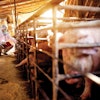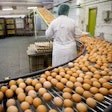
The slow growth of certain organic commodities in the U.S. has increased organic feed producers' reliance on imports, according to a new report on the state of organic livestock feed and commodities.
Despite growing demand for organic feed, and particularly for organic protein meal, U.S. production of corn, wheat and soybeans has not kept pace, said Ryan Koory, a senior economist for Mercaris, a market data service and online trading platform specializing in organics. While growth in domestic corn and wheat production may make up some of the difference this coming season, the feed industry is increasingly reliant on imports of organic soybean meal, which has begun to undercut domestic growers, Koory said.
The primary source of the growth, according to Koory, is increased consumer demand for organic poultry, which has more than offset slowing growth in the organic dairy sector. Overall demand for organic feed is expected to grow 6-7%, and demand for protein meal is especially high.
That, in turn, has put pressure on organic soybean meal supplies, leading to a rapid increase in soybean imports, Koory said. Organic soybean production expanded 13% in 2018-19, according to the debut Organic Commodities Outlook released by Mercaris last week. However, growth in expansion did not keep up with demand, leading producers to rely more heavily on imported soybean meal, which is less readily available in the U.S. than whole organic soybeans due to low domestic demand for soybean oil. Consequently, Mercaris projects a 35% increase in soybean meal imports, while domestic supply is expected to contract by 4%.
“The thing I’m watching this year,” he said, “is how the trade situation continues to develop on soybeans. Another major thing to look at, with slower growth in corn and wheat, is do we have the potential for a large acreage expansion this year? Those are important factors to watch.”
While organic wheat production reached record levels in 2018-19, expanding 8% year-over-year, it’s not expected to keep pace with demand in the future. Mercaris projects wheat production will grow an additional 4% in the coming year, while demand for organic wheat livestock feed is expected to climb 7%.
Corn, similarly, is struggling to keep pace. U.S. production increased just 2% in 2018-19. However, Koory said he believes the slow growth may be tied to crop rotation, and that U.S. farmers may be able to ramp up production this coming year.
Koory didn’t expect this spring's wet conditions and flooding in the northern and Midwestern United States to have a dramatic impact on organic crop production. Organic farmers typically start their crops later in the year to avoid cross-pollination with non-organic crops, he said.
















